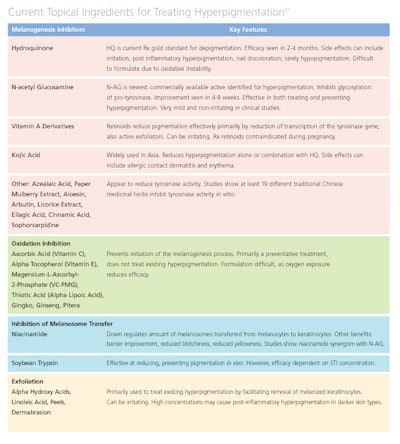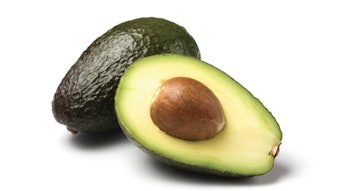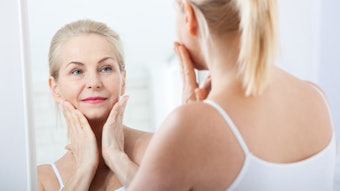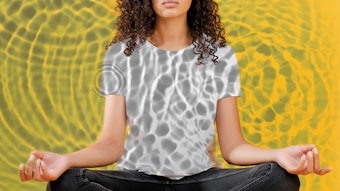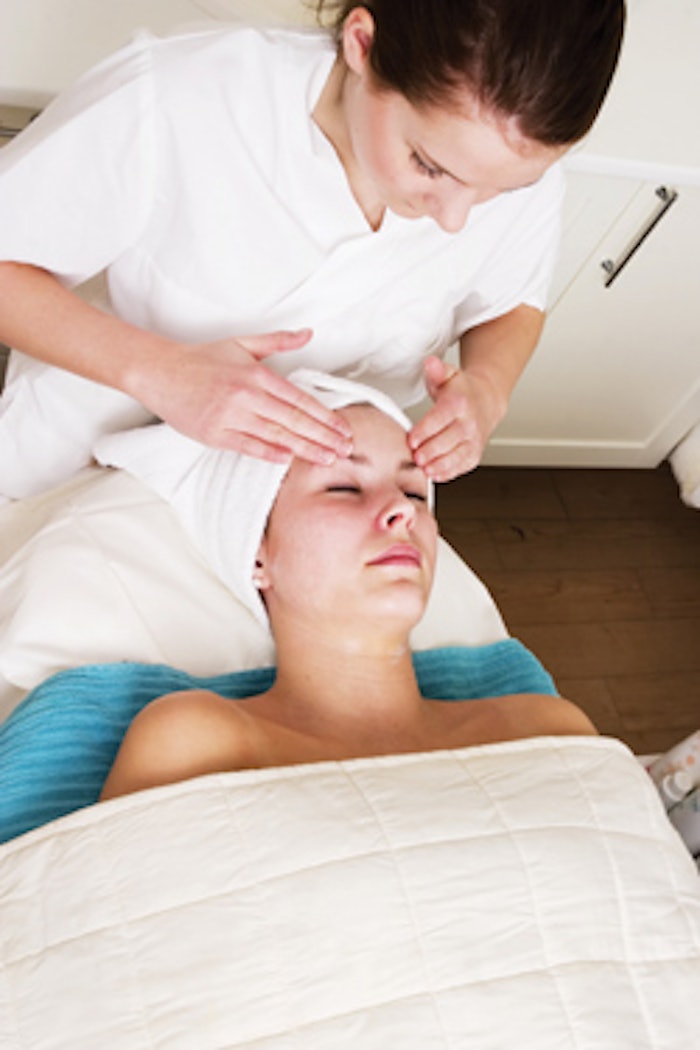
Research shows women want healthy-looking skin, and regardless of where on the color spectrum any one individual is, uniform, even-toned skin is emerging as one of the most critical characteristics of healthy, youthful attractiveness.
In a study conducted by P&G Beauty and two leading evolutionary biologists, Karl Grammer, PhD, and Bernhard Fink, PhD, hyperpigmentation was shown to significantly contribute to the overall appearance of skin aging, just as fine lines and wrinkles do. The study demonstrated that uneven skin tone can add as much as 10 years to an individual’s perceived age.1
As a spa professional, hyperpigmentation may certainly be an area for discussion with many clients, and looking at how skin pigment cells work and learning about some of the technologies that are available to help assess and combat skin discoloration can help you offer better services and treatments.
Getting under the skin
The epidermis is comprised largely of cells called keratinocytes. Keratinocyte cells are formed at the lowest layer of the epidermis and travel upward, evolving and changing as they migrate and eventually becoming the cells that form the outermost layer of the skin, the stratum corneum.2–3
Melanocytes are specialized cells that reside among the keratinocytes in the lowest layer of the epidermis and have the primary function of producing melanin. The melanocyte packages the melanin into organelles called melanosomes, and then transfers these packets of melanin to the keratinocyte cells. The melanocytes are dendritic, meaning they have a branching structure, similar to the look of a tree.2–3 See Figure 1 for an illustrative explanation.
Each melanocyte is able to transfer melanin to as many as 30–36 keratinocyte cells via these dendritic extensions. Once inside the keratinocyte cell, the melanin surrounds the nucleus, essentially forming a protective shield against damaging stimuli, such as UV radiation. As the turnover of the epidermis proceeds, the melanin eventually degrades and breaks down, and the cells are sloughed off through the natural process of desquamation—the shedding of the outer layers of the skin.
Genetics determine the ratio and amount of brown-black eumelanins and yellow-red pheomelanins that melanocytes produce on a regular basis. It is the ratio of these melanins that produces natural skin tone. When exposed to UV radiation, the melanocytes are stimulated to produce more melanin than usual, which causes tanning. Additionally, localized overproduction of melanin can be stimulated in the skin by hormone fluctuations, medication, injury, pollution, free radicals and stress.
As people age, cumulative exposure to UV radiation can damage skin cells, and severe damage can cause a melanocyte to be permanently switched on and overproduce melanin. This may result in the formation of solar lentigines, or what are called age or liver spots. Research has shown there are more active melanocytes in chronically sun-exposed skin than in non-exposed skin.4
Shedding light on skin optics and tone
Reflection and refraction of light play a large role in the perception of overall skin tone. About 5% of the light that hits facial skin is reflected off the skin’s surface, while the other 95% penetrates it.5–9 It is this light reflection process that gives human skin its optical depth. The white light passing through skin’s transparent surface reflects off of collagen, which essentially acts as a mirror beneath the surface. As the light reflects back to the surface, it absorbs color from pigments such as melanin and blood within skin’s many layers. Colored light is then diffused softly by the surface, generating a luminous glow.
With aging, collagen becomes more like an antique mirror, and light passes through it, compromising the skin’s ability to reflect and refract light. Additionally, uneven distributions of melanin, or age spots, and hemoglobin, or dilated or broken blood vessels, in the skin can further impede or scatter light, contributing to a dull, less luminous complexion. 5–9 See Figure 2 for an illustrative explanation.
Client options
The desire for even-toned skin is certainly driving clients to seek professional advice. For years, it has been chemical peels, microdermabrasion and laser resurfacing that have been used to treat age spots and other skin imperfections associated with aging and long-term sun exposure.10–13 Removing the outermost layers of skin through exfoliation has been proven as a means to help improve skin texture and tone, and these treatments are still on the rise. According to the American Society of Plastic Surgeons, chemical peels and microdermabrasion were both in the top five minimally invasive cosmetic procedures in 2007, and laser resurfacing treatments also increased by 32% from 2006 to 2007.14
In addition to resurfacing treatments in the clinic or spa, there are also a host of take-home products for topical application with ingredients such as alpha hydroxy acids and linoleic acids that have been shown to encourage exfoliation. Several other ingredients also have been shown in laboratory studies to interrupt the melanogenesis cycle and reduce the outward signs of hyperpigmentation and uneven skin tone.
Hydroquinone is currently considered the gold standard for depigmentation. Right now, it is available in consumer-use products with levels up to 2%, and up to 4% by physician’s prescription. And though hydroquinone is highly effective at interrupting the melanogenesis cycle, it does have several known adverse effects, including irritation, post-inflammatory hyperpigmentation or increased darkening of the skin, nail discoloration and occasionally hypopigmentation—the complete loss of pigmentation or bleaching of the skin.
In years past, the focus has been on ingredients that inhibit the tyrosinase enzyme, the key enzyme involved in the production of melanin. Ingredients such as kojic acid; arbutin; ascorbic acid, or vitamin C; ellagic acid; licorice; sulfhydryl compounds; and resorcinols are effective tyrosinase enzyme inhibitors, and laboratory studies have also shown some of these ingredients have other effects. For example, ascorbic acid and sulfhydryl compounds are also effective antioxidants, which help to protect from free radical damage when applied to the skin’s surface. “It is difficult to directly connect a specific mechanism of an ingredient to the observed effect on pigmentation,” notes P&G Beauty scientist Donald L. Bissett, PhD.
More recent targets explored in the melanogenesis cycle include both the inhibition of glycosylation, a sugar chain reaction necessary for the production of melanin, and preventing the transfer of packaged melanin from the melanocyte cell to the keratinocyte cell. N-acetyl glucosamine (NAG) is an ingredient that has been shown to inhibit the sugar chain reaction, and ingredients such as soybean trypsin and niacinamide are reported to reduce the amount of melanin transferred from cell to cell.
One of the newest kids on the block is the ingredient undecylenoyl phenylalanine (UPA). When keratinocyte skin cells are exposed to ultraviolet light, a cycle of events is activated that eventually leads to the release of a hormone that stimulates nearby melanocytes to produce melanin. UPA has been shown to inhibit this melanin-stimulating hormone from communicating with the melanocyte.
Combining ingredients can sometimes result in an even greater benefit for treating hyperpigmentation. Clinical studies have shown a topical combination of the ingredients niacinamide and NAG had a greater effect on reducing the appearance of facial hyperpigmentation than topical application of NAG alone.15 Table 1 shows some current topical ingredients for treating hyperpigmentation and key features about each ingredient technology.
Sunscreen is also effective in reducing hyperpigmentation by helping to block UV rays, which stimulate melanocytes, from even being absorbed into skin. Clinical studies have shown that combining sunscreens with ingredient technologies such as niacinamide and NAG give greater protection against seasonal skin-darkening than just using sunscreen alone.16
Setting the right tone
Because science is moving quickly to discover and integrate more and better ingredients into products that can positively affect hyperpigmentation and improve overall skin tone, it is essential for estheticians to carefully study the ingredients listed on any products they may use or offer clients in the spa. Clients will hold an informed esthetician in high regard, and that often results in a more successful business for the spa itself.
REFERENCES
1. K Grammer, B Fink and P Matts, “Visible skin color distribution plays a major role in perception of age, attractiveness and health in the female face,” Human Behavior and Evolution Society Annual Meeting, Philadelphia, Poster #53 (2006)
2. JJ Nordlund, RE Boissy, VJ Hearing, RA King and JP Ortonne, The Pigmentary System, Oxford UP, New York (1998)
3. J Gray, The World of Skin Care, Macmillan Press, Ltd.: London (2000)
4. BA Gilchrest, Skin and Aging Processes, CRC Press: Boca Raton, FL (1984)
5. PJ Matts, “Understanding and measuring the optics that drive visual perception of skin appearance,” The Essential Stratum Corneum, Marks, Leveque, Voegeli, eds. Martin Dunitz: London (2002) pp 213–222
6. RR Anderson and JA Parrish, The optics of human skin, J Invest Dermatol 77(1) 13–19 (1981)
7. AA Bashkatov, EA Genina, VI Kochubey and VV Tuchin, Optical properties of human skin, subcutaneous and mucous tissues in the wavelength range from 400 to 2000 nm, J Phys D: Appl Phys 38 2543–55 (2005)
8. JB Dawson, DJ Barker, DJ Ellis, et al., A theoretical and experimental study of light absorption and scattering by in vivo skin, Phys Med Biol 25 695–709 (1980)
9. G Zonios, J Bykowski and N Kollias, Skin melanin, hemoglobin, and light scattering properties can be quantitatively assessed in vivo using diffuse reflectance spectroscopy, J Invest Dermatol 117(6) 1452–7 (2001)
10. BW Rubach, Comparison of Chemical Peel and Dermabrasion to Carbon Dioxide Laser Resurfacing, Operative Techniques in Otolaryngology 8(1) 9–14 (1997)
11. E Whitaker and JM Yarborough, Microdermabrasion, eMedicine Clinical Reference. June 1, 2006
12. MH Gold, Dermabrasion in dermatology, Am J Clin Dermatol 4(7) 467–71 (2003)
13. DA Sherris, CC Otley and GB Bartley, Comprehensive treatment of the aging face—cutaneous and structural rejuvenation, Mayo Clin Proc Feb 73(2) 139–46 (1998)
14. American Society of Plastic Surgeons, 2008 Report of the 2007 Statistics, National Clearinghouse of Plastic Surgery Statistics, www.plasticsurgery.org
15. DL Bisset, LR Robinson, PS Raleigh, et al., Reduction in the appearance of facial hyperpigmentation by topical N-acetyl glucosamine, J Cosmet Dermatol 6 20–26 (2007)
16. AB Kimball, JR Kaczvinsky, DL Bissett, et al.,Reduction in the appearance of facial hyperpigmentation by a combination of topical niacinamide plus N-acetyl glucosamine: results of a randomized, double-blind, placebo-controlled trial, Br J Dermatol (submitted 2009)
